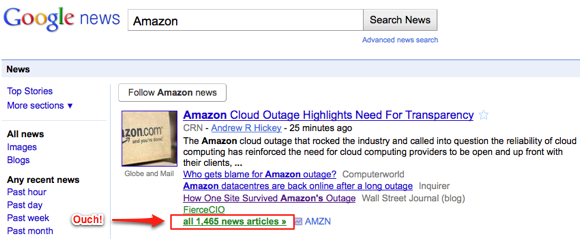
It has probably escaped no one that Amazon had several days of serious issues with its cloud hosting service last week, which took a large number of sites either fully or partly offline, including sites like Reddit, Foursquare and Quora.
To say that this incident received a massive amount of media attention would be an understatement. The screenshot from a Google News search that we included above pretty much says it all (taken last evening).
There’s an old TV news adage that goes, “if it bleeds, it leads.” We’re sure you’ve heard of it. This was the Internet equivalent of that.
This is one of the really big downsides of running such a large operation online as Amazon does (or any really large web hosting company). When something goes down, it gets noticed, big time. It becomes more than a nuisance, it becomes news.
That said, a big outage like this one gives us all…
A chance to learn
We’re sure that although this was a very frustrating incident for everyone involved, both Amazon and its AWS customers will come out of this with several valuable lessons learned. And we don’t think the lesson should be, “don’t trust cloud computing.” That would be very short sighted.
In fact, AWS will most likely become a better service because this. We’ve said it before, and we’ll say it again: Everyone will have downtime. It’s what you learn from it, what you do to minimize future downtime, that matters.
Some have already been generous enough to share their experiences and advice.
- Don MacAskill from the photo sharing service SmugMug has an interesting blog post on how to design sites to survive these kinds of incidents when you host your service “in the cloud.” Some of his advice is AWS-specific, but much of it is relevant regardless of your platform.
- Jeff Atwood of Coding Horror and Stack Overflow fame points out some valuable advice from Netflix, which uses AWS extensively, and shares some of his own experiences with Stack Exchange.
- Platform as a Service provider Heroku has published a postmortem on the AWS outage with a lot of valuable insights and advice. It’s a great insider’s view of the incident.
- Cloud management service Rightscale has a nice summary of the Amazon incident plus an analysis of what they and others can learn from it. They also have some additional links that you can check out.
- Dave Jilk from Standing Cloud urges us all to learn the right lessons from the Amazon outage.
If you use Amazon EC2 or some other cloud computing platform, these articles are pretty much a must-read. Even if you’re on a more traditional hosting platform, we recommend you check out the articles anyway since much of what they discuss is relevant to all web services.



























